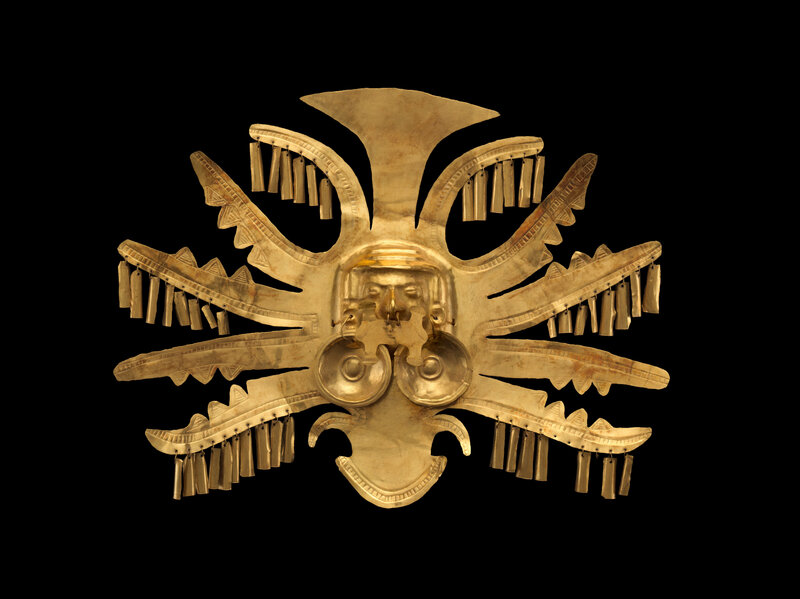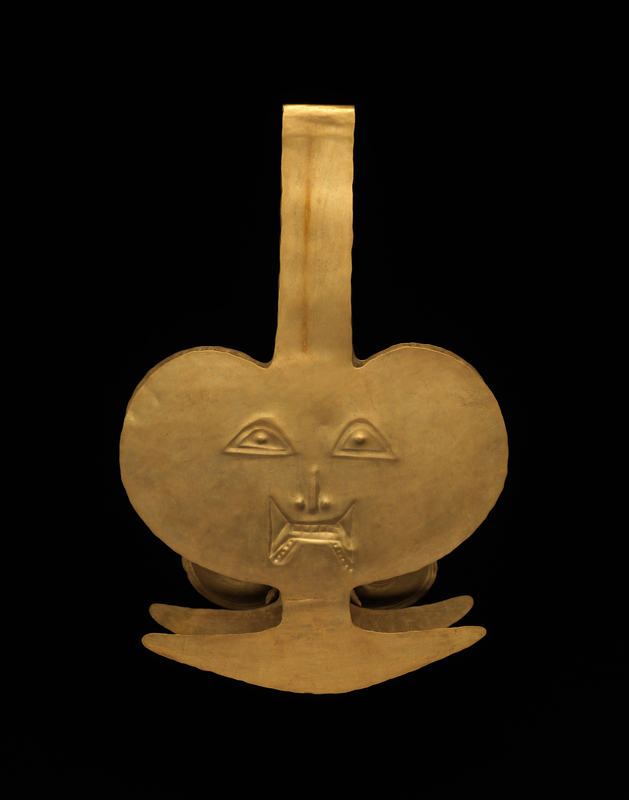Colombian Calima Jewelry from 'The Body Transformed' At The Met Fifth Avenue
Headdress Ornament, 1st–7th century, Calima art (Yotoco period), Colombia. Gold. H. 8 5/8 in. (21.9 cm). Gift and Bequest of Alice K. Bache, 1966, 1977, 66.196.24. © 2000–2018 The Metropolitan Museum of Art.
Five lateral rays project out from either side of this gold Calima headdress ornament, surrounding central crescent-shaped projections located both above and below a central face rendered in high relief. When worn, the lower central crescent-shaped element would have covered the wearer’s forehead and nose. The rays may have been designed to emulate the plumage of an elaborate feather headdress with their slightly curved forms with three notched triangular elements and linear designs. Every other ray has a series of dangling pendants attached by small gold wires, increasing in number from six to eight to ten, successively from top to bottom, with three pendants missing from the bottom ray on the right. When the wearer moved, these pendants would have swayed back and forth, producing a tinkling sound. This combination of sound and motion would have animated the piece in a dramatic fashion.
The face in high relief at the center of the headdress ornament wears a dome-shaped cap with two small rectangular forms above the forehead. Two large, circular, convex ear pendants with concave circular forms at the centers hang from gold wires. An H-shaped nose pendant covers the mouth and lower face, exposing only the closed or squinted eyes. The nose pendant itself bears a smaller, more stylized face in low relief. Through layers of adornment and repetition, this headdress ornament simultaneously reveals and conceals faces.
The H-shaped nose pendant is a hallmark of Yotoco-period Calima art. The Yotoco period was the second of three societies—Ilama, Yotoco-Malagana, and Sonso—to successively occupy the Cauca Valley region in west-central Colombia. The three societies are known collectively as the Calima culture. Faces in Yotoco artwork are often inexpressive, and represent idealized types rather than true portraiture. This type of face is also commonly found on pectorals (see 1979.206.507), where they also bear little to no variation in features across different pieces. Some scholars have suggested stylistic similarities between Calima gold figures and the stone sculptures found at San Agustín, an archaeological site in west-central Colombia, due to the recurrence of impassive faces with dome-shaped caps as a central motif.
The gold in this piece was first hammered into a sheet and subsequently cut into the desired shape. The artist then added details by further shaping the sheet with a bone or metal tool over a soft anvil made of leather or a sack of fine sand. It is likely that the face in high relief was sculpted over a mold.
This type of headdress ornament, often called frontals as they would have been affixed to the front of a turban-like textile or basketry headdress, would have served as a resplendent manifestation of status and wealth. The gold frontal, with its delicate, moving pendants, would have caught and reflected sunlight, or even fire light. Headdress frontals would have been worn as part of a suite of ornaments with similar iconographic elements that adorned the torso, neck, and head, almost entirely obscuring the face (see 66.196.23, 1974.271.51, and 1979.206.506). Dressed in full regalia, Calima elites would have shone brightly, channeling the sun’s divinity and force as a source of life and renewal.
Andrés A. Bustamante, 2015.
Pectoral with Face, 1st–7th century, Calima art (Yotoco period), Colombia. Gold (hammered). H. 8 3/4 x W. 11 x D. 1 3/8 in. (22.2 x 27.9 x 3.5 cm). The Michael C. Rockefeller Memorial Collection, Bequest of Nelson A. Rockefeller, 1979, 1979.206.507. © 2000–2018 The Metropolitan Museum of Art.
A large H-shaped nose pendant almost entirely obscures the face at the center of this gold, kidney-shaped pectoral. Both the shape of the pectoral and the form of the nose pendant are hallmarks of Yotoco-period Calima art. The Yotoco period was the second of three societies—Ilama, Yotoco-Malagana, and Sonso—to successively occupy the Cauca Valley region in west-central Colombia. The three societies are known collectively as the Calima culture.
The upper portions of the eyes are just visible above the H-shaped pendant, and the head itself is surmounted by a dome shaped cap with a small rectangular crest at the top. Two large, circular, convex ear pendants with concave, circular centers hang from gold wires. The H-shaped pendant itself bears a smaller, more stylized embossed face. Through layers of adornment and repetition, the pectoral simultaneously reveals and conceals faces
Faces in Yotoco artwork are often inexpressive, and represent idealized types rather than true portraiture. This type of face is also commonly found on headdress ornaments (see 66.196.24), where they also bear little variation across different works. Some scholars have suggested stylistic similarities between Calima gold figures and stone sculptures found at San Agustín, an archaeological site in west-central Colombia, due to the recurrence of impassive faces with dome-shaped caps as a central motif. The design along the border of the pectoral, framed by a row of raised dots, resembles decorative details painted on ceramics from this region
The pectoral was shaped by first hammering a gold-copper alloy known as tumbaga into a sheet, which was subsequently cut into the desired shape. The artist could then add details by working the sheet with a bone or metal tool over a soft anvil made of leather or a sack of fine sand. It is likely that the face in high relief was shaped over a mold.
The pectoral would have been worn over the chest, suspended by a cord through the two small holes located directly above the cap. Pectorals would have been worn as part of a suite of ornaments with similar iconographic elements that adorned the torso, neck, and head, almost entirely obscuring the face (see 66.196.23, 1974.271.51, and 1991.419.40). Dressed in full regalia, Calima elites would have shone brightly, channeling the sun’s divinity and force as a source of life and renewal.
Andrés A. Bustamante, 2015.
Arm Ornament, 100 B.C.–A.D. 800, Calima art (Yotoco period), Colombia, Calima River region. Hammered gold. H. 10 7/8 in. (27.6 cm). Gift and Bequest of Alice K. Bache, 1974, 1977, 1974.271.51. © 2000–2018 The Metropolitan Museum of Art.
Beginning in the last century before the Common Era, and continuing on until the ninth century, master metalsmiths in what is now southwestern Colombia created remarkable full-body regalia for powerful leaders to wear in life, and also in death. These included ear ornaments, headdress diadems, pectorals, and tweezer-like objects that are thought to have been worn suspended from a cord tied around the upper arm. Sometimes called brazeletes in Spanish, this impressive example boasts an embossed face, bilateral flanges, and a crescent-shaped blade at the base.
The conventionalized visage rendered in high relief on this ornament, often called the “Yotoco Face,” is characteristic of this period, and is also found on pectorals and diadems (see 1979.206.507). The face itself is adorned with other ornaments, including an H-shaped nose ornament—itself bearing a face rendered in low relief—and large, circular ear pendants. Yotoco (100 B.C. – A.D. 800) was the second of three cultures identified archaeologically in the Cauca Valley. Along with the earlier Ilama, and the later Sonso, these three societies are known collectively as the Calima culture.
Ornaments such as this example were created by hammering gold into a sheet, and then cutting it into the desired shape. The metalsmith would then add details by working the sheet from the reverse using a bone or metal tool over a soft material. Elements such as the conventionalized face were likely achieved by hammering the sheet over a form.
Although this object is most often called an arm ornament, the presence of a simpler face rendered in low relief on the reverse side, however, calls into question its exact function, as the presence of two faces may suggest it was meant to be seen from both sides. Although seemingly a curious form of decoration to modern viewers, tweezerlike ornaments were a common symbol of power and authority throughout the western reaches of the ancient Americas.
Nose Ornament, 1st–7th century, Calima art (Yotoco period), Colombia. Gold. H. 5 5/16 in. (13.5 cm). Gift and Bequest of Alice K. Bache, 1966, 1977; 66.196.23. © 2000–2018 The Metropolitan Museum of Art.
'The Body Transformed' At The Met Fifth Avenue, november 12, 2018–february 24, 2019

/https%3A%2F%2Fprofilepics.canalblog.com%2Fprofilepics%2F1%2F0%2F100183.jpg)
/https%3A%2F%2Fstorage.canalblog.com%2F03%2F02%2F119589%2F96711876_o.jpg)
/https%3A%2F%2Fstorage.canalblog.com%2F11%2F31%2F119589%2F94773502_o.jpg)
/https%3A%2F%2Fstorage.canalblog.com%2F20%2F83%2F119589%2F94772815_o.jpg)
/https%3A%2F%2Fstorage.canalblog.com%2F26%2F72%2F119589%2F75604929_o.jpg)
/https%3A%2F%2Fstorage.canalblog.com%2F59%2F60%2F119589%2F26458628_o.jpg)







/http%3A%2F%2Fstorage.canalblog.com%2F31%2F43%2F119589%2F92667491_o.jpg)
/image%2F1371349%2F20240425%2Fob_c453b7_439605604-1657274835042529-47869416345.jpg)
/image%2F1371349%2F20240425%2Fob_59c6f0_440358655-1657722021664477-71089985267.jpg)
/image%2F1371349%2F20240425%2Fob_07a28e_440353390-1657720444997968-29046181244.jpg)